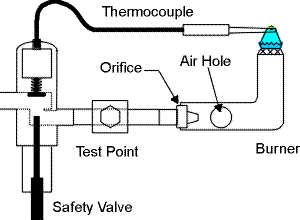Dave's Place
Safety System

You should read the section on gas safety before attempting any repairs.
The purpose of the safety system is to shut off the flow of propane if the burner flame goes out. It is comprised of the flame itself, the thermocouple, and the safety valve.
The burner flame is lit by pushing the button at the bottom of the safety valve, which in turn temporarily pushes the plunger inside the safety valve open and allows propane to flow through. Once the burner is lit, the thermocouple will begin to generate millivolts (after about 10 to 30 seconds of being heated) and will energize the electromagnet inside the safety valve. Once energized the electromagnet holds the plunger inside the safety valve in the open position. The plunger has to have been pushed all the way up for the electromagnet to be able to hold it in place. If the the burner flame goes out for some reason, the thermocouple will cool after about 10 to 30 seconds and quit generating millivolts. The electromagnet will then de-energize, and the plunger will snap shut, cutting off the flow of propane.
If, after lighting the burner and releasing the button on the safety valve, the flame goes out immediately or shortly thereafter, you have a problem with the safety system. One of the three components is failing to to its job. It could be that the flame isn't hot enough, the thermocouple is not generating enough or any millivolts, or the electromagnet inside the safety valve has failed.
WARNING
Do not prop the button on the safety valve into the open position as a temporary fix.
If the burner flame
were to go out, propane would flow indefinitely and could very easily explode if ignited.
If you you're going to guess which component is the problem, always bet on the thermocouple. Be sure the tip of it is in the burner flame, and also inspect the tip of it for damage, such as chunks missing from it. Don't overlook the other components of the safety system, however, but it's a pretty puny flame that won't create enough heat for the thermocouple, and the electromagnet has a fairly low failure rate. If you have no strong reasons to suspect the flame or the safety valve, always replace the thermocouple first if you have a problem.
Sometimes, the flame will stay lit while the refrigerator is cooling, and then drop out when the burner flame is reduced by the thermostat to the lower by-pass flame. This could be because of too low of a by-pass flame or a weak thermocouple. Check to be sure that the tip of the thermocouple is still in the flame when the flame is in by-pass mode. If the initial cooling down period of the refrigerator seems normal and the flame then drops out, change the thermocouple first. If the cooling down period seems longer than normal, then see the poor cooling section under gas diagnosis. Try to avoid messing with the size of the by-pass, because you will probably end up with an over cooling problem.
If your safety system seems to work well under normal conditions, but the flame blows out when traveling, see the Flame Blow Out page for a few hints.RV Refrigerator Home
This RV refridgerator information was originally located on rvmobile.comRV Mobile Inc. 11715 HWY 99, Everett, WA 98204
The owner of RV Mobile Inc. apparently suffered a heart attack and the original website was shut down.
It has been reposted here to preserve this wealth of information RV refridgerator information.